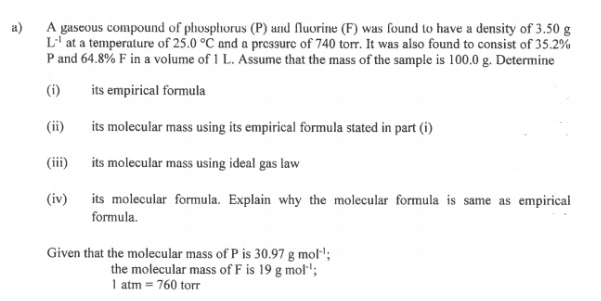A gaseous compound of phosphorus (P) and fluorine (F) was found to have a density of 3.50 g L' at a temperature of 25.0 °C and a prcssure of 740 torr. It was also found to consist of 35.2% P and 64.8% F in a volume of 1 L. Assume that the mass of the sample is 100.0 g. Determine a) (i) its empirical formula (ii) its molecular mass using its empirical formula stated in part (i) (iii) its molecular mass using ideal gas law (iv) its molecular formula. Explain why the molecular formula is same as empirical formula. Given that the molecular mass of P is 30.97 g mol·'; the molecular mass of F is 19 g mol'; 1 atm = 760 torr
A gaseous compound of phosphorus (P) and fluorine (F) was found to have a density of 3.50 g L' at a temperature of 25.0 °C and a prcssure of 740 torr. It was also found to consist of 35.2% P and 64.8% F in a volume of 1 L. Assume that the mass of the sample is 100.0 g. Determine a) (i) its empirical formula (ii) its molecular mass using its empirical formula stated in part (i) (iii) its molecular mass using ideal gas law (iv) its molecular formula. Explain why the molecular formula is same as empirical formula. Given that the molecular mass of P is 30.97 g mol·'; the molecular mass of F is 19 g mol'; 1 atm = 760 torr
Chemistry & Chemical Reactivity
10th Edition
ISBN:9781337399074
Author:John C. Kotz, Paul M. Treichel, John Townsend, David Treichel
Publisher:John C. Kotz, Paul M. Treichel, John Townsend, David Treichel
Chapter10: Gases And Their Properties
Section: Chapter Questions
Problem 105IL: You have a gas, one of the three known phosphorus-fluorine compounds (PF3, PF3, and P2F4). To find...
Related questions
Question
100%

Transcribed Image Text:A gaseous compound of phosphorus (P) and fluorine (F) was found to have a density of 3.50 g
L' at a temperature of 25.0 °C and a pressurc of 740 tor. It was also found to consist of 35.2%
P and 64.8% F in a volume of 1 L. Assume that the mass of the sample is 100.0 g. Determine
a)
(i)
its empirical formula
(ii)
its molecular mass using its empirical formula stated in part (i)
(iii)
its molecular mass using ideal gas law
(iv) its molecular formula. Explain why the molecular formula is same as empirical
formula.
Given that the molecular mass of P is 30.97 g mol';
the molecular mass of F is 19 g mol';
1 atm = 760 torr
Expert Solution
This question has been solved!
Explore an expertly crafted, step-by-step solution for a thorough understanding of key concepts.
This is a popular solution!
Trending now
This is a popular solution!
Step by step
Solved in 3 steps with 2 images

Knowledge Booster
Learn more about
Need a deep-dive on the concept behind this application? Look no further. Learn more about this topic, chemistry and related others by exploring similar questions and additional content below.Recommended textbooks for you

Chemistry & Chemical Reactivity
Chemistry
ISBN:
9781337399074
Author:
John C. Kotz, Paul M. Treichel, John Townsend, David Treichel
Publisher:
Cengage Learning

Chemistry & Chemical Reactivity
Chemistry
ISBN:
9781133949640
Author:
John C. Kotz, Paul M. Treichel, John Townsend, David Treichel
Publisher:
Cengage Learning

Chemistry: The Molecular Science
Chemistry
ISBN:
9781285199047
Author:
John W. Moore, Conrad L. Stanitski
Publisher:
Cengage Learning

Chemistry & Chemical Reactivity
Chemistry
ISBN:
9781337399074
Author:
John C. Kotz, Paul M. Treichel, John Townsend, David Treichel
Publisher:
Cengage Learning

Chemistry & Chemical Reactivity
Chemistry
ISBN:
9781133949640
Author:
John C. Kotz, Paul M. Treichel, John Townsend, David Treichel
Publisher:
Cengage Learning

Chemistry: The Molecular Science
Chemistry
ISBN:
9781285199047
Author:
John W. Moore, Conrad L. Stanitski
Publisher:
Cengage Learning

Introductory Chemistry: A Foundation
Chemistry
ISBN:
9781337399425
Author:
Steven S. Zumdahl, Donald J. DeCoste
Publisher:
Cengage Learning

Chemistry: Principles and Reactions
Chemistry
ISBN:
9781305079373
Author:
William L. Masterton, Cecile N. Hurley
Publisher:
Cengage Learning

Chemistry: An Atoms First Approach
Chemistry
ISBN:
9781305079243
Author:
Steven S. Zumdahl, Susan A. Zumdahl
Publisher:
Cengage Learning